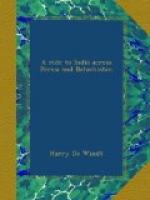An old Jew having previously agreed to convert, at exorbitant interest, our rouble notes into “sheis” and kerans, negotiations for horses were then opened by Gerome, and, as the patois spoken in Astara is a mixture of Turkish and Persian, with a little Tartar thrown in, his task was no easy one, especially as every one spoke at once and at the top of their voices. We discovered at last that but few of the villagers owned a horse, and those who did were very unwilling to let the animal for such an uncertain journey. “Who is going to guarantee that the ‘Farangis’ will not steal it?” asked one ragged, wild-looking fellow in sheepskins and a huge lamb’s-wool cap. “Or get it stolen from them?” added another, with a grin. “They can have my old grey mare for two hundred kerans, but you won’t catch me letting her for hire,” added a third.
With the aid of our friend, the Jew, however, we finally persuaded the sheepskin gentleman (a native of Khiva) to change his mind. After considerable haggling as to price, he disappeared, to return with two of the sorriest steeds I ever set eyes on. “We ought to reach Enzelli in about three days, if we do not get our throats cut,” said the Khivan, who was to accompany us, encouragingly.
Hassan had been busy in our absence; he had prepared an excellent pilaff, and sent to Russian Astara for some kaketi wine, which was brought over in a goatskin. This, with our own provisions bought in the morning, furnished a substantial and much-needed meal. Persian native bread is somewhat trying at first to a weak digestion. It is unleavened, baked in long thin strips, and is of suet-like consistency. The hut, like most native houses in Persia, had no chimney, the only outlet for the smoke being through the narrow doorway. This necessitates lying flat on one’s back in the clear narrow space between smoke and flooring, or being suffocated—a minor inconvenience as compared with others in Persian travel.
The Khivan arrived with the horses at six next morning. By seven o’clock we were well on the road, which for the first ten miles or so led by the sea-shore, through dense thickets of brushwood, alternating with patches of loose drifting sand. I was agreeably disappointed in the ponies; for though it was deep, heavy going, they stepped out well and freely. The clear sunshine, keen air, and lovely scenery seemed to have the same inspiriting effect on them as on ourselves.
The coup d’oeil was indeed a lovely one. To our right a glorious panorama of palm, forest, and river stretched away for miles, bounded on the horizon by a chain of lofty precipitous mountains, their snowy peaks white and dazzling against the deep cloudless blue, their grassy slopes and rocky ravines hidden, here and there, by grey mists floating lazily over depths of dark green forest at their feet. To our left broad yellow sands, streaked with seaweed and dark driftwood, and cold grey waters of the Caspian Sea—colourless and dead even under this Mediterranean sky, and bringing one back, so to speak, from a beautiful dream to stern reality.




